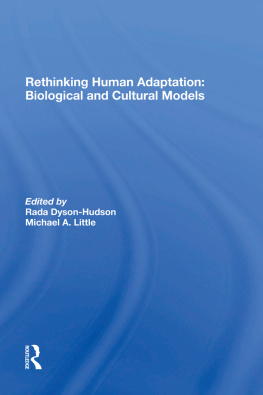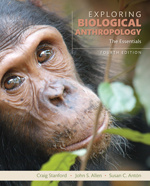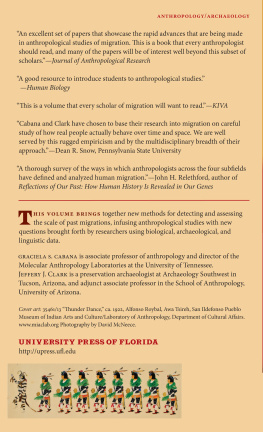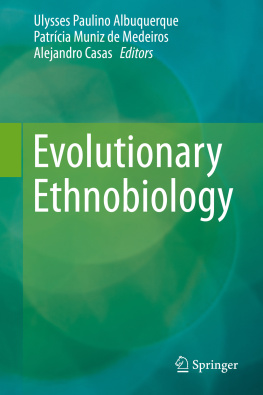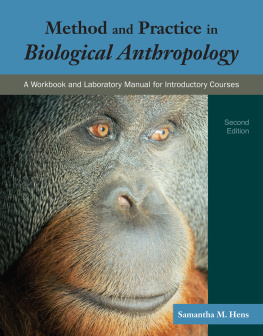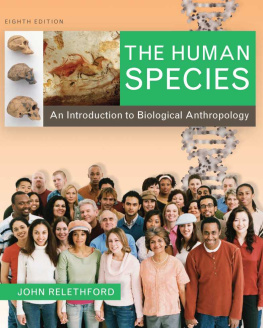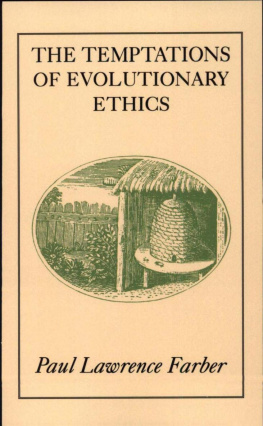Rethinking Human Adaptation
Also of Interest
*Human Adaptability: An Introduction to Ecological Anthropology, Emilio F. Moran
*Soeiobiology: Beyond Nature/Nurture? Reports, Definitions and Debate, edited by George W. Barlow and James Silverberg
*Biology and the Social Sciences: An Emerging Revolution, edited by Thomas C. Wiegele
*A Systems View of Man, Ludwig von Bertalanffy, edited by Paul A. LaViolette
*The Women of Rural Asia, Robert Orr White and Pauline Whyte
India: Cultural Patterns and Processes, edited by Allen G. Noble and Ashok K. Dutt
Resource Managers: North American and Australian Hunter-Gatherers, edited by Nancy M. Williams and Eugene S. Hunn
Involuntary Migration and Resettlement: The Problems and Responses of dislocated People, edited by Art Hansen and Anthony Oliver-Smith
*Available in hardcover and paperback.
A Westview Special Study
Rethinking Human Adaptation: Biological and Cultural Models
edited by Rada Dyson-Hudson and Michael A. Little
Most anthropologists agree that a comprehension of adaptation and adaptive processes is central to an understanding of human biological and behavioral systems. However, there is little agreement among archeologists, cultural anthropologists, and human biologists as to what adaptation means and how it should be analyzed. Because of this lack of a common underlying theory, method, and perspective, the subdisciplines have tended to move apart, and anthropology is no longer the integrated science envisaged at its inception in the nineteenth century.
In this book, the authorsboth biological and cultural anthro-pologistsuse a common theoretical framework based on recent evolutionary, ecological, and anthropological theory in their analyses of biological and social adaptive systems. Although a synthesis of the subdisciplines of anthropology lies somewhere in the future, the original essays in this volume are a first attempt at a unified perspective.
Dr. Rada Dyson-Hudson is associate professor in the Department of Anthropology, Cornell University. In the past, she was associate professor and research associate in the Department of Pathobiology at the School of Hygiene, Johns Hopkins University. Her attempt to reconcile the implications of natural selection theory with a commitment to social equality led to a rethinking of human adaptation and, among other things, the organization of the symposium at the American Anthropological Association of which this book is a result. Dr. Michael A. Little is professor of anthropology at the State University of New York at Binghamton. He has been scientific coordinator of the Human Adaptability Section of the International Biological Program and is coauthor of Ecology, Energetics, and Human Variability (1976).
Rethinking Human Adaptation: Biological and Cultural Models
edited by Rada Dyson-Hudson and Michael A. Little
First published 1983 by Westview Press
Published 2019 by Routledge
52 Vanderbilt Avenue, New York, NY 10017
2 Park Square, Milton Park, Abingdon, Oxon OX14 4RN
Routledge is an imprint of the Taylor & Francis Group, an informa business
Copyright 1983 by Taylor & Francis
All rights reserved. No part of this book may be reprinted or reproduced or utilised in any form or by any electronic, mechanical, or other means, now known or hereafter invented, including photocopying and recording, or in any information storage or retrieval system, without permission in writing from the publishers.
Notice:
Product or corporate names may be trademarks or registered trademarks, and are used only for identification and explanation without intent to infringe.
Library of Congress Catalog Card Number 82-83813
ISBN 13: 978-0-367-28589-0(hbk)
The editors acknowledge the following people for help, in a variety of ways, in the preparation of this book: Barbara Donne11, Davydd J. Greenwood, Glenn Hausfater, Robert Netting, Lynne Rienner, and Coraleen Rooney. We thank, particularly, Kenneth A, R. Kennedy, who commented on the entire manuscript. We thank, also, the contributors to this book for their patience.
R. D-H.
M.A.L.
The concept of adaptation is central to an understanding of human biology and behavior. Although biologists' studies of adaptation are firmly rooted in Darwin's theory of evolution through natural selection, anthropologists generally deal with morphological, physiological, and behavioral (cultural) adaptations as if they represent quite different phenomena. In this book, we suggest that Darwinian theory can provide a body of theory appropriate for the analysis of both biological and cultural adaptation. Only by focusing on interactive patterns in biological and behavioral systems can we understand human biological and cultural adaptive responses.
In their analysis of human biology and behavior, the authors in this volume approach adaptation from an interactive rather than a deterministic mode. Dyson-Hudson presents a model for the development of all human phenotypes which emphasizes that these must be based not only on evolved genetic programs but also on the environmental information encountered during the entire lifetime of the individual. Kellum and Haas demonstrate that deterministic models cannot deal adequately with biological phenomena such as the variations in human sex ratios at birth and variations in human reproductive success in high Andean populations. Interactive models are also clearly required for an understanding of human behavioral adaptations traditionally studied by cultural ecologists and ecological anthropologists. Moran, Dow, and Boone demonstrate the importance of considering environmental variables in assessing the adaptiveness of spatial mobility, "primitive" warfare, and warfare in complex and hierarchical societies. Smith shows that, by using interactive models based on a synthesis of neo-Darwinian theory with evolutionary ecology, human behavioral adaptations can be analyzed within the theoretical framework of recent advances in biology.
Anthropology has, since its inception, been identified as an integrated biological and social science. However, in recent years the sub-fields have tended to move apart in method, theory, and content. The contributions to this book, by sociocultural and biological anthropologists, treat adaptation within the framework of recent evolutionary theory. This is a positive trend and we firmly believe that only by these integrated approaches can adaptation in human populations be fully understood.
1
An Interactive Model of Human Biological and Behavioral Adaptation
Rada Dyson-Hudson
Editors' Summary : In the first chapter, Rada Dyson-Hudson emphasizes an evolutionary perspective, based on Darwinian theory, on human biological and behavioral adaptation. Her approach differs from more deterministic scientists in its attempt to deal with the environmental lability of most human genetic systems and the tight interaction among behavioral, biological, and environmental features of human populations. Dyson-Hudson believes that if there is to be a unified theory of biological and cultural adaptation, it must be based on an explicit recognition that natural selection is the only force which can generate and maintain adaptation.

